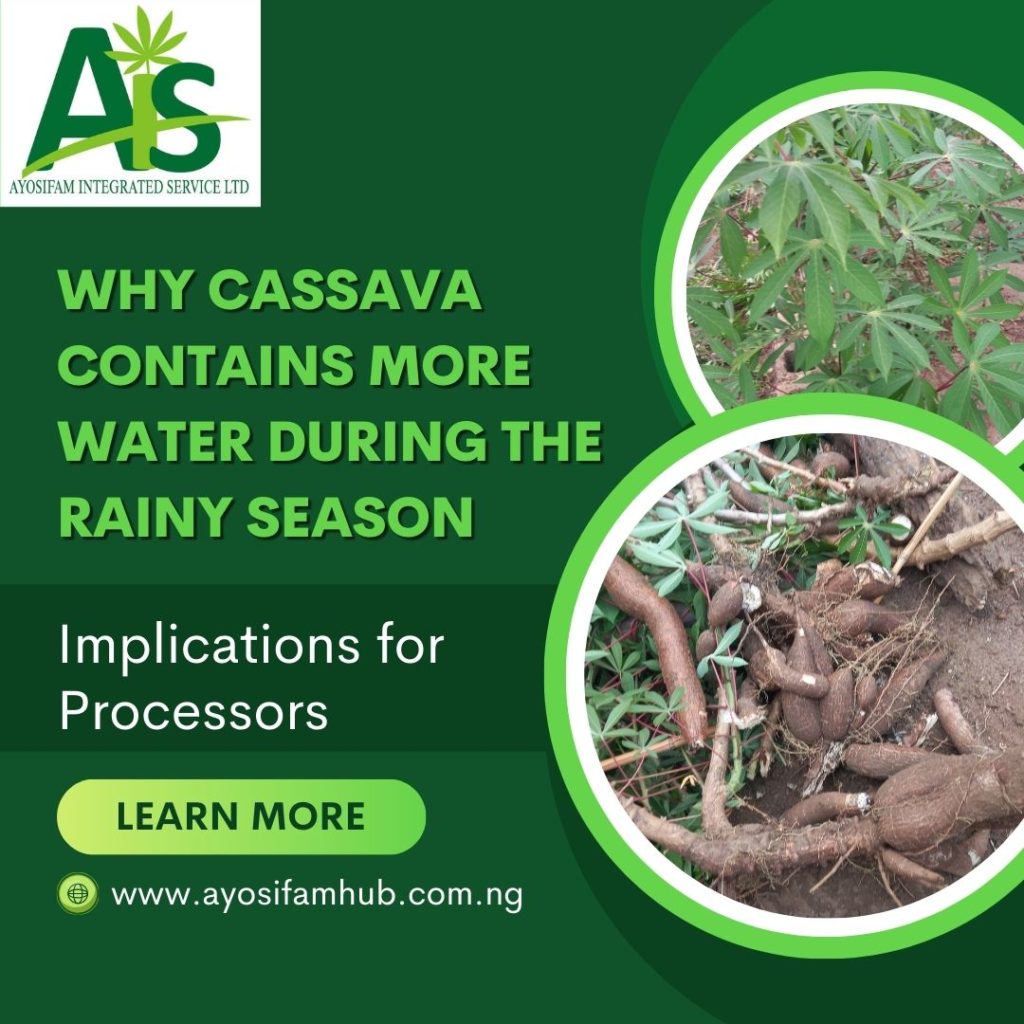Cassava, a vital staple crop in many tropical regions, exhibits a significant increase in water content during the rainy season. This phenomenon is primarily due to increased soil moisture availability and the plant’s natural physiological response to abundant water.
During periods of heavy rainfall, the soil becomes saturated, providing cassava plants with ample water for absorption through their extensive root systems. As a result, the tubers accumulate more water, leading to a higher moisture content at harvest. This is a natural mechanism for the plant to support its growth and metabolic processes when water is readily available.
While increased water availability is generally beneficial for crop growth, the higher moisture content in cassava harvested during the rainy season presents several challenges for processors. Understanding these implications is crucial for efficient and high-quality cassava processing.
What Processors Should Know:
Lower Dry Matter Content: Cassava harvested in the rainy season will have a lower percentage of dry matter (starch and other solids) compared to cassava harvested during the dry season. This directly impacts the yield of processed products like flour, starch, and chips. Processors should anticipate needing a larger quantity of fresh cassava to achieve the same amount of dry product.
Increased Processing Time and Energy Costs: The higher water content necessitates longer drying times to achieve the desired moisture levels in the final products. This translates to increased energy consumption for artificial drying methods or extended periods for sun-drying, which can be particularly challenging during the rainy season due to reduced sunlight and high humidity.
Potential for Spoilage: Cassava roots with high moisture content are more susceptible to microbial spoilage and enzymatic deterioration. This is because the increased water activity provides a favourable environment for the growth of moulds and bacteria. Processors need to handle and process the cassava quickly to minimise post-harvest losses.
Challenges in Traditional Processing Methods: Traditional processing methods like sun drying become less efficient and more challenging during the rainy season. The lack of consistent sunshine and high humidity hinder the drying process, increasing the risk of spoilage and compromising the quality of the final product.
Impact on Product Quality: The quality of some cassava-based products can be affected by the higher water content. For instance, gari produced from high-moisture cassava may have a shorter shelf life if not adequately dried. The texture and other physicochemical properties of starch and flour can also be influenced.
Need for Efficient Water Removal Techniques: Processors should prioritise efficient water removal techniques, especially during the rainy season. This may involve investing in mechanical dewatering equipment before drying, optimising drying parameters (temperature, airflow), or exploring alternative drying technologies suitable for high humidity conditions.
Proper Storage of Fresh Cassava: Given the increased perishability, proper storage of fresh cassava before processing is critical. Strategies such as storing in well-ventilated areas, using clamps or trenches, or even submerging in water for short periods can help extend the shelf life. However, these methods have limitations and are not long-term solutions.
Adjusting Processing Parameters: Processors may need to adjust their processing parameters based on the moisture content of the incoming cassava. This could involve modifying grating sizes, fermentation times (if applicable), and drying protocols to ensure optimal product quality and yield.
Consideration of Planting and Harvesting Schedules: Where feasible, processors can collaborate with farmers to strategically plan planting and harvesting schedules to minimise processing during the peak rainy season and maximise the dry matter content of the harvested cassava.
Investment in Drying Infrastructure: For consistent year-round production, especially in regions with prolonged rainy seasons, investing in reliable and efficient drying infrastructure (e.g., flash dryers, rotary dryers) becomes essential to overcome the limitations of sun-drying.
In conclusion, the higher water content in cassava during the rainy season is an important factor that processors must consider. By understanding the reasons behind this phenomenon and its implications for processing, they can adopt appropriate strategies to mitigate the challenges, maintain product quality, and ensure efficient operations throughout the year.




